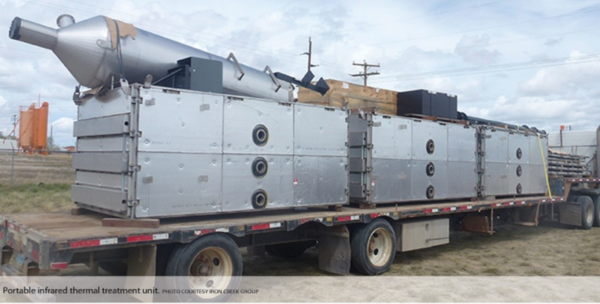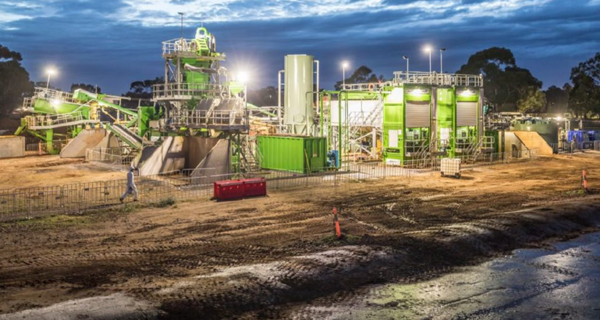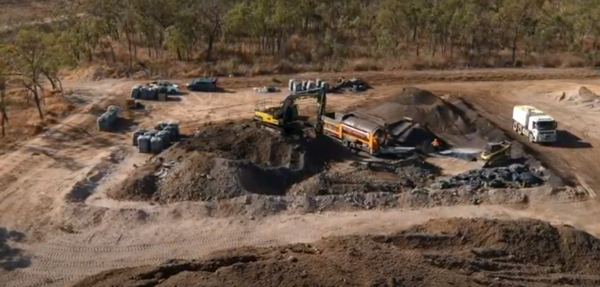PFAS Soil Remediation Technologies
Perfluoroalkyl and Polyfluoroalkyl Substances (PFAS) are mobile in the subsurface and highly resistant to natural degradation processes, therefore soil source areas can be ongoing sources of groundwater contamination. The United States Environmental Protection Agency (US EPA) has not promulgated soil standards for any PFAS, although a handful of states have for select compounds. Soil standards issued for protection of groundwater are in the single digit part per billion range, which is a very low threshold for soil impacts. Well developed soil treatment technologies are limited to capping and excavation with incineration or disposal. Soil stabilization with sorptive amendments and soil washing have been applied at limited locations. At present, no in situ destructive soil treatment technologies have been demonstrated at full scale.
Related Article(s):
Contributor(s): James Hatton and William DiGuiseppi
Key Resource(s):
- ITRC Fact Sheet: Treatment Technologies, PFAS – Per- and Polyfluoroalkyl Substances[1].
- Persistence of Perfluoroalkyl Acid Precursors in AFFF-Impacted Groundwater and Soil[2].
Introduction
PFAS are a class of highly fluorinated compounds including perfluorooctane sulfonate (PFOS), perfluorooctanoic acid (PFOA), and many other compounds with a variety of industrial and consumer uses. These compounds are often highly resistant to treatment[3] and the more mobile compounds are often problematic in groundwater systems[4]. The US EPA has published lifetime drinking water health advisories for the combined concentration of 70 nanograms per liter (ng/L) for two common and recalcitrant PFAS: PFOS, a perfluoroalkyl sulfonic acid (PFSA), and PFOA, a perfluoroalkyl carboxylic acid (PFCA)[5][6].(See Perfluoroalkyl and Polyfluoroalkyl Substances (PFAS) for nomenclature.)
While many of the earliest sites where these compounds were detected in groundwater were manufacturing sites, some recent detections have been attributed to fire training activities associated with aqueous film-forming foams (AFFF). AFFF is the US Department of Defense (DoD) designation for Class B firefighting foam containing PFAS, which is required for fighting fires involving petroleum liquids. Fire training areas and other source areas where AFFF was released at the surface have the potential to be ongoing sources of groundwater contamination[2]. (See also PFAS Sources.)
No national soil cleanup standards have been promulgated by the US EPA, although Regional Screening Levels (RSLs) have been calculated and published for perfluorobutane sulfonate (PFBS)[7] and data are available to calculate RSLs for PFOA and PFOS[8]. Several states have promulgated standards[9] or screening levels[10][11][12][13][14] for soil concentrations protective of groundwater, which are several orders of magnitude lower than direct dermal exposure guidelines. These single-digit part per billion criteria will likely drive remedial actions in PFAS source areas in the future. At present, the lack of federally promulgated standards and uncertainty about future standards causes temporary stockpiling of PFAS-impacted soils on sites with soil generated from construction or investigation activities.
Soil Treatment
Addressing recalcitrant contaminants in soil has traditionally been done through containment/capping or excavation and off-site disposal or treatment, typically by incineration. Containment/capping may be an acceptable solution for PFAS in some locations. However, containment/capping is not considered ideal given the history of releases from engineered landfills and restrictions on use of land containing capped soils. Innovative but less established treatment approaches for PFAS in soil include stabilization with amendments, soil washing, and low temperature thermal desorption.
Excavation and Disposal
Excavation and off-site disposal or treatment of PFAS-impacted soils is the only well-developed treatment technology option and may be acceptable for small quantities of soil, such as those generated during characterization activities (i.e., investigation derived waste, IDW). Disposal in non-hazardous landfills is allowable in most states. However, some landfill operators are choosing to restrict acceptance of PFAS-containing waste and soils as a protection against future liability. In addition, the US EPA and some states are considering or have designated PFOA and PFOS as hazardous substances, which would reduce the number of facilities where disposal of PFAS-contaminated soil would be allowed[15]. Treatment of excavated soils is commonly performed using incineration or other high temperature thermal methods[1]. Recent negative publicity regarding incomplete combustion of PFAS in incinerators[16] has caused some states to ban PFAS incineration in some circumstances[17].
Stabilization

Various amendments have been manufactured to sorb PFAS to reduce leaching from soil. Although this is a non-destructive approach, stabilization can reduce mass flux from a source area or allow soils to be placed in landfills with reduced potential for leaching. Amendments sorb PFAS through hydrophobic and electrostatic interactions and are applied to soil through in situ soil mixing or ex situ stabilization (Figure 1). Effectiveness of amendments varies depending on site conditions, PFAS types present, and mixing conditions[8]. Good results have been observed in bench and field scale tests with a variety of cationic clays (natural or chemically modified) and zeolites[19][20][21]. Bench-scale tests have shown that activated carbon sorbents reduce leachability of PFAS from soils[22][23][24]. Several commercial products have been developed to target PFAS, including CETCO’s Fluoro-Sorb® and Ziltek’s RemBind™, the latter of which combines the cation exchange binding capability of clays, the hydrophobic sorption and van der Waals attraction of organic material, and the electrostatic interactions of aluminum hydroxide to create a highly effective soil stabilizer. This material has been mixed into soil at 1 to 5% ratio by weight in ex situ applications and been demonstrated to reduce leachability by greater than 99 percent[25].
Thermal Treatment

Incineration: Incineration is a well-developed technology for organics destruction, including PFAS-impacted soils. Incineration is generally defined as high temperature (>1,100°C) thermal destruction of waste, and PFAS are thought to mineralize at high temperatures. Generally, incinerators treat off-gasses by thermal oxidation with temperatures as high as 1,400°C, and vaporized combustion products can be captured using condensation and wet scrubbing[8]. Some regulatory officials have expressed concern about possible PFAS emissions in off-gas from these incinerators, and the authors are not aware of any published evidence demonstrating complete mineralization of multiple PFAS in incinerators at the time of this posting. In general, incineration is designed to provide “5 nines of destruction” – destruction of 99.999% of the contaminants, although incinerators are not designed to specifically treat PFAS to this standard. In the absence of approved industry standard test methods, the US EPA is developing off-gas/stack testing procedures capable of detecting PFAS at the levels considered to be harmful[27].
Thermal Desorption: Thermal Desorption of PFAS from soil has been demonstrated at the field scale in the US (Alaska)[28][29] and Australia[25] using rotary kilns operating at temperatures of up to 815°C with off-gas treatment at up to 1200°C, or in other cases using batch-fed systems (Figure 2) operating at lower temperatures. At these temperatures, some PFAS are mineralized, releasing fluorine that must be captured in off-gas treatment systems. Some PFAS would not be destroyed at these temperatures and therefore must be captured in off-gas treatment systems. Several bench-scale tests have been performed that have established a minimal effective temperature for desorption of between 350°C and 400°C[30][18]. A US Department of Defense (DoD) Strategic Environmental Research and Development Program (SERDP) field-scale demonstration was performed in Oregon, where ex situ thermal desorption was conducted at 400°C over several days, and the PFAS were captured on vapor-phase activated carbon and subsequently incinerated off site[30]. Two field-scale thermal desorption pilot projects (one in situ and the other ex situ) have been funded under the US DoD’s Environmental Security Technology Certification Program (ESTCP) to demonstrate that source zone soil can be heated to the requisite 350°C and held there for the appropriate length of time to fully desorb and capture PFAS[31][32].
Soil Washing
Soil washing has been applied to PFAS in a handful of pilot projects[33][34][35] and one full-scale implementation in Australia (Figure 3). This approach requires a large-scale engineered plant to handle the various liquid and solid waste streams generated. Soil washing is less suitable for clay-rich soils, where aggregation of the particulates occurs and is difficult to prevent or mitigate. Treatment of the liquid rinse water waste stream is required, which would then rely on conventional water treatment technologies such as granular activated carbon (GAC) or ion exchange. Additionally, in some cases flocculated sludge is generated, which would require treatment or disposal offsite. At present, the only full-scale soil washing project is in Australia, where a vendor has constructed and is operating a AUD$ 10 million treatment plant primarily for treatment of soils generated from remedial actions at Australian Defense installations. Some Australian installations are stockpiling soils due to the lack of cost-effective soil treatment options. According to the vendor, this system generates no solid waste, instead feeding any solids back into the front end of the process for further removal of PFAS[26].
Conclusions
Several well-developed remedial technologies have been applied to address soil contaminated with PFAS (Figure 4). Unfortunately, none of the available techniques are ideal, with some reducing leachability but leaving the PFAS-impacted soil in place, while others result in destruction of the contaminants but require high energy inputs with associated high cost.
References
- ^ 1.0 1.1 Interstate Technology and Regulatory Council (ITRC), 2020. PFAS Technical and Regulatory Guidance Document and Fact Sheets, PFAS-1. PFAS Team, Washington, DC. Website Report.pdf
- ^ 2.0 2.1 Houtz, E.F., Higgins, C.P., Field, J.A., and Sedlak, D.L., 2013. Persistence of Perfluoroalkyl Acid Precursors in AFFF-Impacted Groundwater and Soil. Environmental Science and Technology, 47(15), pp. 8187−8195. DOI: 10.1021/es4018877
- ^ Kissa, Erik, 2001. Fluorinated Surfactants and Repellents: Second Edition. Surfactant Science Series, Volume 97. Marcel Dekker, Inc., CRC Press, New York. 640 pages. ISBN 978-0824704728
- ^ Backe, W.J., Day, T.C., and Field, J.A., 2013. Zwitterionic, Cationic, and Anionic Fluorinated Chemicals in Aqueous Film Forming Foam Formulations and Groundwater from U.S. Military Bases by Nonaqueous Large-Volume Injection HPLC-MS/MS. Environmental Science and Technology, 47(10), pp. 5226-5234. DOI: 10.1021/es3034999
- ^ US Environmental Protection Agency (EPA), 2016. Drinking Water Health Advisory for Perfluorooctane Sulfonate (PFOS), EPA 822-R-16-004. Office of Water, Health and Ecological Criteria Division, Washington, DC. Free download from US EPA Report.pdf
- ^ US Environmental Protection Agency (EPA), 2016. Drinking Water Health Advisory for Perfluorooctanoic Acid (PFOA), EPA 822-R-16-005. Office of Water, Health and Ecological Criteria Division, Washington, DC. Free download from US EPA Report.pdf
- ^ US Environmental Protection Agency (EPA), 2020. Regional Screening Levels (RSLs) – User's Guide. Washington, DC. Website
- ^ 8.0 8.1 8.2 Interstate Technology Regulatory Council (ITRC), 2020. PFAS Water and Soil Values Table. PFAS – Per- and Polyfluoroalkyl Substances: PFAS Fact Sheets. Free download. 2020 Water and Soil Tables (excel file)
- ^ Alaska Department of Environmental Conservation (AK DEC), 2020. 18 AAC 75, Oil and Other Hazardous Substances Pollution Control. Anchorage, AK. Free download. Report.pdf
- ^ Maine Department of Environmental Protection (ME DEP), 2018. Maine Remedial Action Guidelines (RAGs) for Sites Contaminated with Hazardous Substances. Augusta, ME. Free download. Report.pdf
- ^ Michigan Department of Environment, Great Lakes, and Energy (EGLE), 2020. Cleanup Criteria Requirements for Response Activity (Formerly the Part 201 Generic Cleanup Criteria and Screening Levels). Remediation and Redevelopment Division, Lansing, MI. Website
- ^ Nebraska Department of Energy and Environment (NE DEE), 2018. Voluntary Cleanup Program Remedial Goals, Table A-1: Groundwater and Soil Remediation Goals. Lincoln, NE. Free download. Report.pdf
- ^ North Carolina Department of Environmental Quality (NC DEQ), 2020. Preliminary Soil Remediation Goals (PSRG) Table. Raleigh, NC. Free download. Report.pdf
- ^ Texas Commission on Environmental Quality (TCEQ), 2021. Texas Risk Reduction Program (TRRP), Tier 1 Protective Concentration Levels (PCL) Tables. Free Download. 2021 PCL Tables (excel file)
- ^ US Environmental Protection Agency (EPA), 2019. EPA’s Per- and Polyfluoroalkyl Substances (PFAS) Action Plan: EPA 823R18004. Washington, DC. Website Report.pdf 2020 Update
- ^ Cheryl Hogue, 2020. Incineration may spread, not break down PFAS. Chemical and Engineering News, American Chemical Society. Website Report.pdf
- ^ New York State Senate, 2020. An ACT prohibiting the incineration of aqueous film-forming foam containing perfluoroalkyl and polyfluoroalkyl substances in certain cities. Website Report.pdf
- ^ 18.0 18.1 DiGuiseppi, W., Richter, R., and Riggle, M., 2019. Low Temperature Desorption of Per- and Polyfluoroalkyl Substances. The Military Engineer, 111(719), pp. 52-53. Society of American Military Engineers, Washington, DC. Open access article. Report.pdf
- ^ Ochoa-Herrera, V., and Sierra-Alvarez, R., 2008. Removal of perfluorinated surfactants by sorption onto granular activated carbon, zeolites and sludge. Chemosphere, 72(10), pp. 1588-1593. DOI: 10.1016/j.chemosphere.2008.04.029
- ^ Rattanaoudom, R., Visvanathan, C., and Boontanon, S.K., 2012. Removal of Concentrated PFOS and PFOA in Synthetic Industrial Wastewater by Powder Activated Carbon and Hydrotalcite. Journal of Water Sustainability, 2(4), pp. 245-248. Open access article. Report.pdf
- ^ Ziltek, 2017. RemBind: Frequently Asked Questions. Free download Report.pdf
- ^ Du, Z., Deng, S., Bei, Y., Huang, Q., Wang, B., Huang, J. and Yu, G., 2014. Adsorption behavior and mechanism of perfluorinated compounds on various adsorbents – A review. Journal of Hazardous Materials, 274, pp. 443-454. DOI: 10.1016/j.jhazmat.2014.04.038
- ^ Yu, Q., Zhang, R., Deng, S., Huang, J. and Yu, G., 2009. Sorption of perfluorooctane sulfonate and perfluorooctanoate on activated carbons and resin: Kinetic and isotherm study. Water Research, 43(4), pp. 1150-1158. DOI: 10.1016/j.watres.2008.12.001
- ^ Szabo, J., Hall, J., Magnuson, M., Panguluri, S., and Meiners, G., 2017. Treatment of Perfluorinated Alkyl Substances in Wash Water Using Granular Activated Carbon and Mixed Media, EPA/600/R-17/175. US Environmental Protection Agency (EPA), Washington, DC. Website Report.pdf
- ^ 25.0 25.1 Nolan, A., Anderson, P., McKay, D., Cartwright, L., and McLean, C., 2015. Treatment of PFCs in Soils, Sediments and Water, WC35. Program and Proceedings, CleanUp Conference 2015. Cooperative Research Centre for Contamination Assessment and Remediation of the Environment (CRC Care), Melbourne, Australia. pp. 374-375. Free download Report.pdf
- ^ 26.0 26.1 Grimison, C., Brookman, I., Hunt, J., and Lucas, J., 2020. Remediation of PFAS-related impacts – ongoing scrutiny and review, Ventia Submission to PFAS Subcommittee of the Joint Standing Committee on Foreign Affairs, Defence and Trade, Australia. Free download. Report.pdf
- ^ US Environmental Protection Agency (EPA), 2018. PFAS Research and Development, Community Engagement in Fayetteville, North Carolina. Website Report.pdf
- ^ NRC Alaska LLC, 2019. Moose Creek Facility, Thermal Remediation of PFAS-Contaminated Soil. Website Report.pdf
- ^ Burke, Jill, 2019. Fairbanks incinerator shows promise for cleaning toxic soil. Channel 2-KTUU, October 8. Website
- ^ 30.0 30.1 Hatton, J., Dasu, K., Richter, R., Fitzpatrick, T., and Higgins, C., 2019. Field Demonstration of Infrared Thermal Treatment of PFAS-impacted Soils from Subsurface Investigations. Strategic Environmental Research and Development Program (SERDP), Project ER18-1603, Alexandria, VA. Website Report.pdf
- ^ Iery, R., 2020. In Situ Thermal Treatment of PFAS in the Vadose Zone, Project ER20-5250. US Department of Defense, Environmental Security Technology Certification Program (ESTCP). Website
- ^ Jennifer Wehrmann, 2020. Ex Situ Thermal Treatment of Perfluoroalkyl and Polyfluoroalkyl Substances, ER20-5198. US Department of Defense, Environmental Security Technology Certification Program (ESTCP). Website
- ^ Torneman, N., 2012. Remedial Methods and Strategies for PFCs. Fourth Joint Nordic Meeting on Remediation of Contaminated Sites, NORDROCS 2012, Oslo, Norway. Free download. Report.pdf
- ^ Toase, D., 2018. Application of enhanced soil washing techniques to PFAS contaminated source zones. Emerging Contaminants Summit 2018, Westminster, Colorado.
- ^ Grimison, C., Barthelme, S., Nolan, A., Cole, J., Morrell, C., 2018. Integrated Soil and Water System for Treatment of PFAS Impacted Source Areas, 18E138P. Australasian Land and Groundwater Association (ALGA), Sydney, Australia. Free download. Report.pdf
